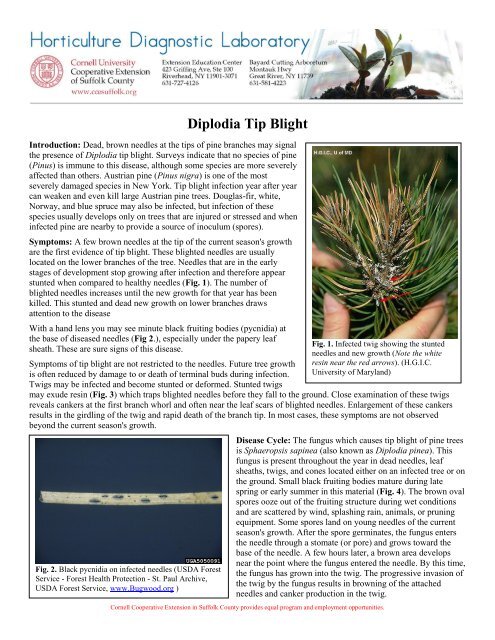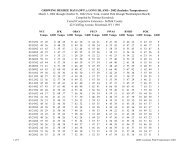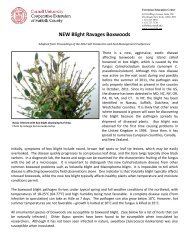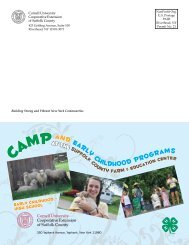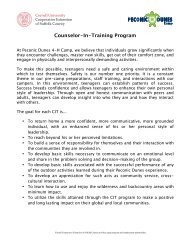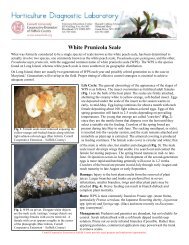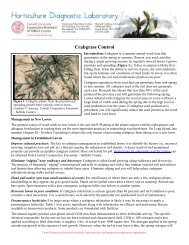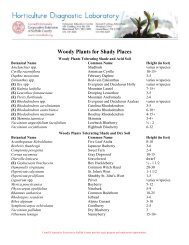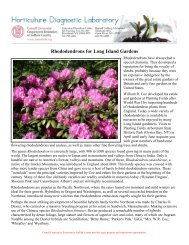Diplodia Tip Blight - Cornell Cooperative Extension of Suffolk County
Diplodia Tip Blight - Cornell Cooperative Extension of Suffolk County
Diplodia Tip Blight - Cornell Cooperative Extension of Suffolk County
Create successful ePaper yourself
Turn your PDF publications into a flip-book with our unique Google optimized e-Paper software.
<strong>Diplodia</strong> <strong>Tip</strong> <strong>Blight</strong><br />
Introduction: Dead, brown needles at the tips <strong>of</strong> pine branches may signal<br />
the presence <strong>of</strong> <strong>Diplodia</strong> tip blight. Surveys indicate that no species <strong>of</strong> pine<br />
(Pinus) is immune to this disease, although some species are more severely<br />
affected than others. Austrian pine (Pinus nigra) is one <strong>of</strong> the most<br />
severely damaged species in New York. <strong>Tip</strong> blight infection year after year<br />
can weaken and even kill large Austrian pine trees. Douglas-fir, white,<br />
Norway, and blue spruce may also be infected, but infection <strong>of</strong> these<br />
species usually develops only on trees that are injured or stressed and when<br />
infected pine are nearby to provide a source <strong>of</strong> inoculum (spores).<br />
Symptoms: A few brown needles at the tip <strong>of</strong> the current season's growth<br />
are the first evidence <strong>of</strong> tip blight. These blighted needles are usually<br />
located on the lower branches <strong>of</strong> the tree. Needles that are in the early<br />
stages <strong>of</strong> development stop growing after infection and therefore appear<br />
stunted when compared to healthy needles (Fig. 1). The number <strong>of</strong><br />
blighted needles increases until the new growth for that year has been<br />
killed. This stunted and dead new growth on lower branches draws<br />
attention to the disease<br />
With a hand lens you may see minute black fruiting bodies (pycnidia) at<br />
the base <strong>of</strong> diseased needles (Fig 2.), especially under the papery leaf<br />
sheath. These are sure signs <strong>of</strong> this disease.<br />
Symptoms <strong>of</strong> tip blight are not restricted to the needles. Future tree growth<br />
is <strong>of</strong>ten reduced by damage to or death <strong>of</strong> terminal buds during infection.<br />
Twigs may be infected and become stunted or deformed. Stunted twigs<br />
may exude resin (Fig. 3) which traps blighted needles before they fall to the ground. Close examination <strong>of</strong> these twigs<br />
reveals cankers at the first branch whorl and <strong>of</strong>ten near the leaf scars <strong>of</strong> blighted needles. Enlargement <strong>of</strong> these cankers<br />
results in the girdling <strong>of</strong> the twig and rapid death <strong>of</strong> the branch tip. In most cases, these symptoms are not observed<br />
beyond the current season's growth.<br />
Fig. 2. Black pycnidia on infected needles (USDA Forest<br />
Service - Forest Health Protection - St. Paul Archive,<br />
USDA Forest Service, www.Bugwood.org )<br />
Fig. 1. Infected twig showing the stunted<br />
needles and new growth (Note the white<br />
resin near the red arrows). (H.G.I.C.<br />
University <strong>of</strong> Maryland)<br />
Disease Cycle: The fungus which causes tip blight <strong>of</strong> pine trees<br />
is Sphaeropsis sapinea (also known as <strong>Diplodia</strong> pinea). This<br />
fungus is present throughout the year in dead needles, leaf<br />
sheaths, twigs, and cones located either on an infected tree or on<br />
the ground. Small black fruiting bodies mature during late<br />
spring or early summer in this material (Fig. 4). The brown oval<br />
spores ooze out <strong>of</strong> the fruiting structure during wet conditions<br />
and are scattered by wind, splashing rain, animals, or pruning<br />
equipment. Some spores land on young needles <strong>of</strong> the current<br />
season's growth. After the spore germinates, the fungus enters<br />
the needle through a stomate (or pore) and grows toward the<br />
base <strong>of</strong> the needle. A few hours later, a brown area develops<br />
near the point where the fungus entered the needle. By this time,<br />
the fungus has grown into the twig. The progressive invasion <strong>of</strong><br />
the twig by the fungus results in browning <strong>of</strong> the attached<br />
needles and canker production in the twig.<br />
<strong>Cornell</strong> <strong>Cooperative</strong> <strong>Extension</strong> in <strong>Suffolk</strong> <strong>County</strong> provides equal program and employment opportunities.
Management Strategies: The damage caused by this<br />
disease is most severe on old or weakened trees. Old trees<br />
or trees exposed to unsuitable growing conditions,<br />
mechanical injury, or damage by insects may eventually be<br />
killed. Thorough weekly watering during extended dry<br />
periods <strong>of</strong> the growing season and spring broadcast<br />
fertilization will result in a tree that is more vigorous and<br />
more resistant to tip blight.<br />
When only a few branches <strong>of</strong> a tree show symptoms <strong>of</strong> tip<br />
blight, a program <strong>of</strong> pruning and sanitation should help<br />
minimize disease. Prune <strong>of</strong>f blighted twigs and destroy or<br />
discard them. Since fungal spores can be transported to<br />
healthy twigs during the pruning operation, prune when the<br />
tree is dry. Disinfect pruning tools before each cut by<br />
swabbing the cutting blades with a solution <strong>of</strong> 70% rubbing<br />
alcohol between each cut. Rake up all blighted needles,<br />
twigs, and especially cones which harbor the fungus and<br />
destroy or discard them.<br />
Where disease is severe on smaller landscape trees,<br />
homeowners in New York State may apply some<br />
fungicides containing either potassium bicarbonate or<br />
propiconazole to try to minimize new infections. Follow<br />
label directions. Homeowners are discouraged from trying<br />
to apply pesticides to large landscape specimens, and<br />
should consider hiring a pr<strong>of</strong>essional applicator if good<br />
cultural practices and fertilization do not sufficiently<br />
improve the overall health <strong>of</strong> such trees.<br />
Reprinted from <strong>Diplodia</strong> <strong>Tip</strong> <strong>Blight</strong> Sphaeropsis sapinea,<br />
The Plant Disease Diagnostic Clinic at <strong>Cornell</strong> University,<br />
Ithaca, NY. Updated, SLJ, 6/09.<br />
The Pesticide Management Education Program (PMEP), in<br />
cooperation with the New York State Department <strong>of</strong><br />
Environmental Conservation (NYSDEC), maintains a web<br />
site with a searchable database for pesticide products<br />
currently registered in New York State. Individuals who<br />
have Internet access can locate currently registered<br />
products containing the active ingredients suggested above at http://pims.psur.cornell.edu/index.php(NYS PIMS).<br />
This publication contains pesticide recommendations. Changes in pesticide regulations occur constantly and<br />
human errors are still possible. Some materials mentioned may no longer be available, and some uses may no<br />
longer be legal. All pesticides distributed, sold or applied in New York State must be registered with the New York<br />
State Department <strong>of</strong> Environmental Conservation (NYSDEC). Questions concerning the legality and/or<br />
registration status for pesticide use in New York State should be directed to the appropriate <strong>Cornell</strong> <strong>Cooperative</strong><br />
<strong>Extension</strong> Specialist or your regional NYSDEC <strong>of</strong>fice. Read the label before applying any pesticide.<br />
TK: 1/2010 AW:3/2012<br />
Fig. 3. A stunted dead shoot with exuding resin, which has<br />
turned white and become hardened. (Andrej Kunca, National<br />
Forest Centre - Slovakia, www.Bugwood.org )<br />
Fig. 4. Black pycnidia present on a pine cone.<br />
(H.G.I.C., University <strong>of</strong> Maryland)


